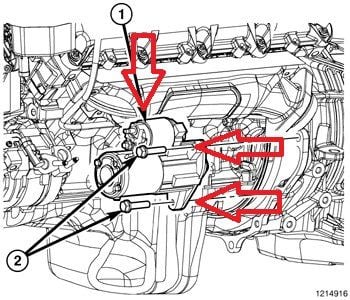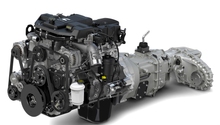Dodge Ram 2009-Present: How to Replace Starter
If your starter motor is just whirring and clicking away, but not actually starting your truck, you have a problem. If everything else points to your Dodge Ram's starter, it's time to replace it.
This article applies to the Dodge Ram 1500 (2009-present).
The starter motor on your Dodge Ram is an electric motor with a gear on the end attached to your engine, specifically, the engine's flywheel (think of it like a big gear attached to the back of the engine, spinning the engine and transmission). When you hop in your Ram and turn the key in the ignition, an electrical signal is sent to the starter, which powers the motor inside of it, turning the little gear on the end of the starter. This little gear meshes with the flywheel, spinning it, causing the engine to "turn over" and spin into life. Understandably, this is a pretty important piece of your engine; no starter means no starting. Fortunately, modern starter motors tend to be quite durable, and usually last well into the 100,000 mile mark. However, as with most things on your vehicle, it is a wear and tear part, and will need to be replaced eventually.
On some engines, the starter is tucked away, pinched between the engine block and vehicle's bulkhead. Fortunately for us, the Ram 1500's Hemi V8 is not one of those engines. Yes, this article is primarily geared towards the Ram 5.7L Hemi V8, though the process should be similar on the Pentastar V6 or the 4.7L V8, with the only major difference being the starter motor's location. With that said, let's get to it.

Materials Needed
- Ratcheting wrench
- 8, 10, 12, 14mm and 7/8" sockets
- Jack and jack stands
Step 1 – Prep your truck
If you have some sort of crazy lift kit on your truck, this doesn't apply to you, but for most of us, it's recommended to get the truck in the air and onto jack stands. You need to have enough clearance to comfortably work underneath it. It is optional, but you can also remove the front wheels for additional working room if you feel the need.
Most 4th gen Rams use a 7/8" socket for the wheel lugs. Break the lugs loose and set your wheels to the side. If your truck has an under-engine plastic splash shield, remove that as well. This is usually secured by 8mm fasteners.
(Related Article - How to Jack Up Your Truck - Dodgeforum.com)
Step 2 – Remove starter
Get underneath your truck and look up towards the driver's (left) side of the engine. You should see the starter poking out from the engine. If your truck is a 4WD model, there may be an accessory brace obscuring access. This brace can just be unbolted and set aside.
The starter is secured with two bolts, which, on most Rams, require a 14mm socket to be taken off. Remove these bolts and slowly extract the starter assembly from the inside of the engine. Be careful to not bang the insides of the starter up.

Slowly is the key word here, because you will notice that there is a small wiring harness attached to the starter. As you pull the starter out, undo the fastener securing the wiring to the chassis. There is also the clip for the harness that must be unconnected as well. With that said, pull the starter and its wiring out and set aside.

Step 3 – Install new starter
Installation is the reverse of removal.
- Carefully fit starter assembly back into its slot.
- Secure the starter assembly with its mounting bolts (torque spec is 50 ft./lb.).
- Connect the harness clip and route the harness as it was originally installed, refitting the harness fastener.
- Connect battery terminals.
- Button up any underbody trays.
- Lower the vehicle down.
Related Discussions
- 2012 Starting Problems - Dodgeforum.com
- Truck Won't Start - Dodgeforum.com
- Truck Won't Start, Lights On - Dodgeforum.com
- Fuel Starve, then Car Won't Start - Dodgeforum.com






